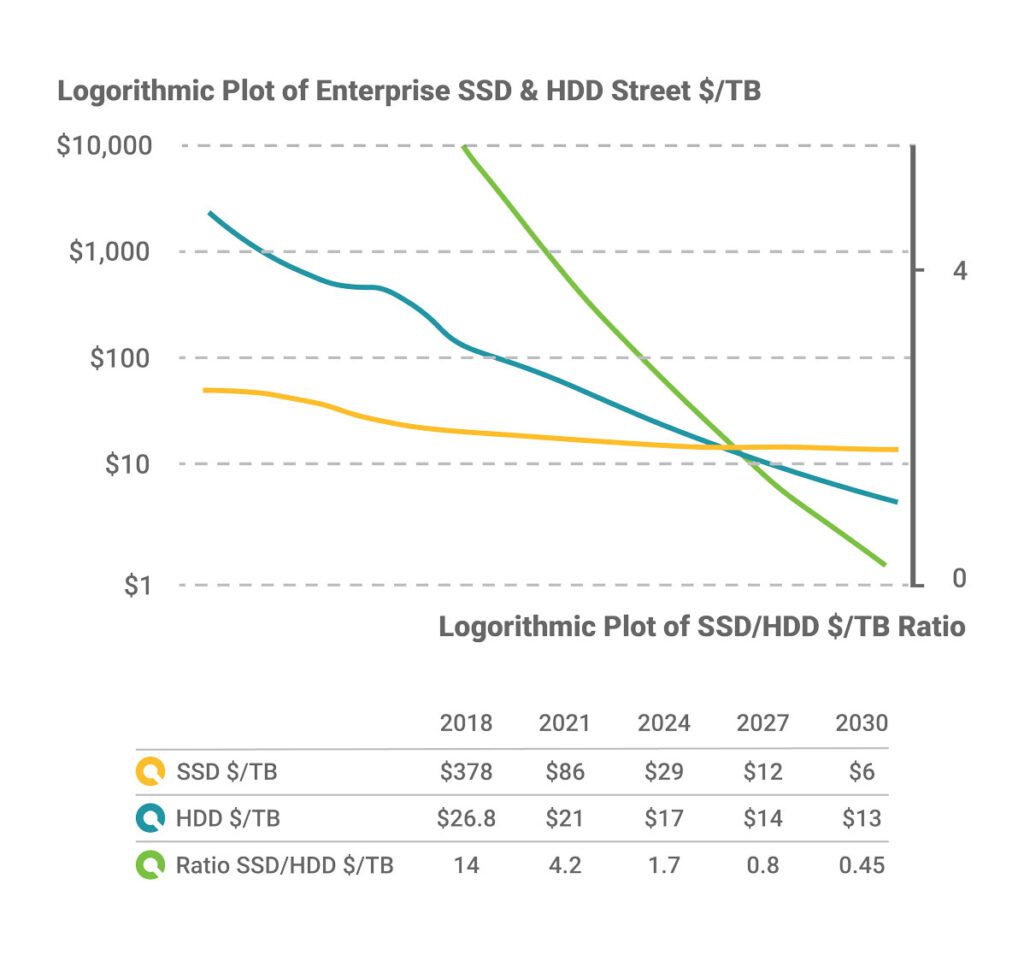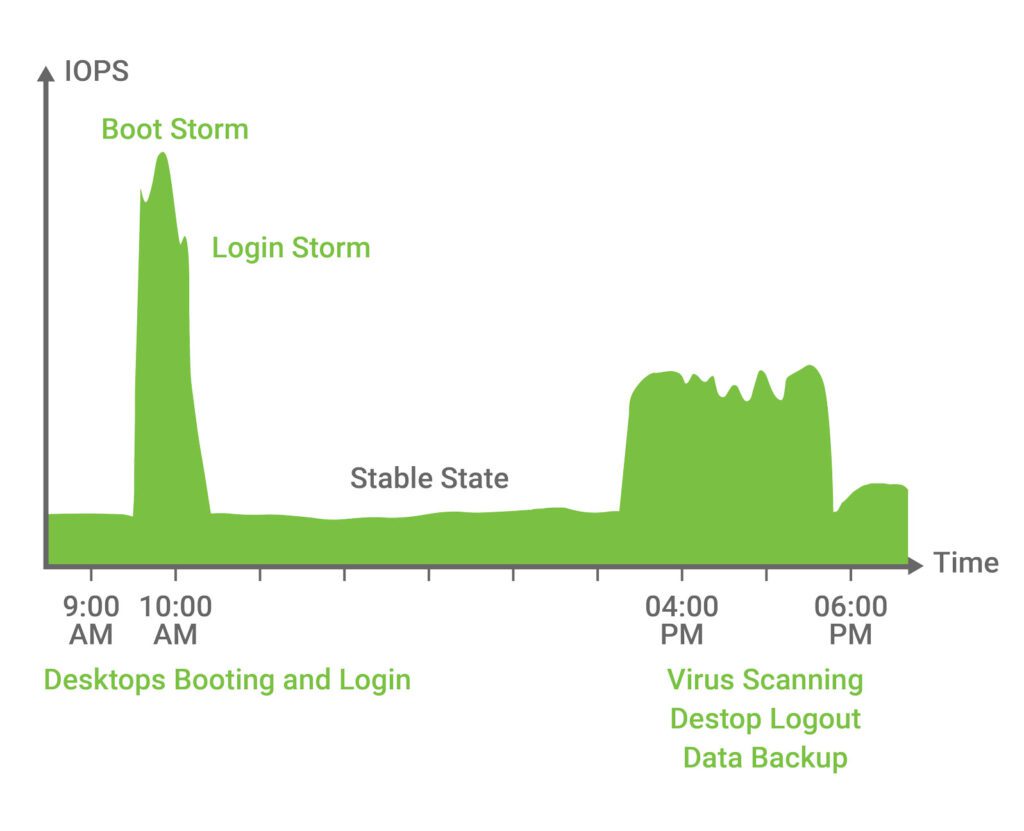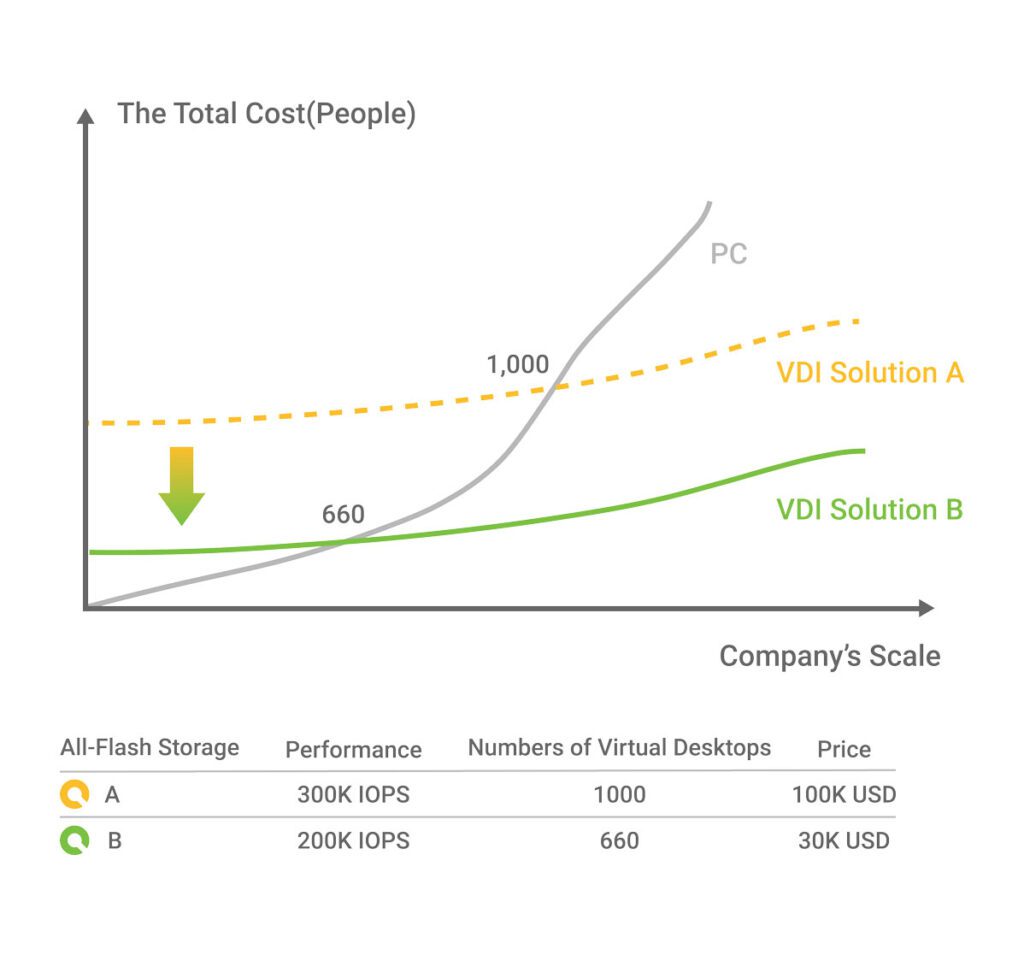突破 VDI 高成本瓶頸
VDI(虛擬桌面基礎架構)是與提供和管理虛擬桌面相關的技術。在 VDI 中,每個使用者可以從任何授權設備訪問個人虛擬桌面,IT 部門則可以集中操作系統和分散在每個使用者電腦上的應用程式,以提高管理和安全性。雖然 VDI 具有許多優點,但高昂的成本是至關重要的閾值之一。VDI 需要高額的軟體授權和強大的硬體設備。大多數中小型企業(SMBs)因預算有限,即使知道 VDI 帶來更多好處,往往也會購買個人電腦而非 VDI。
然而,近年來遠距工作的需求不斷增加,VDI 變得不可或缺。如果企業出於成本考慮採用性能較低的基礎架構來實施 VDI 解決方案,員工會花費大量時間等待虛擬桌面的回應,因為 VDI 無法為每個線上請求提供足夠的運算能力。這將嚴重降低公司的生產力。因此,選擇成本效益和高效能的解決方案,以確保遠程工作不會成為企業生產的瓶頸成為關鍵。
圖 1 為個人電腦和高性能 VDI 的總成本比較圖,個人電腦的初始建設成本非常低,但隨著企業規模擴大及維護成本的增加,建設成本也隨之升高。高速 VDI 的初始建設成本非常高,但透過集中管理,維護變得更簡單。因此,在企業規模達到一定規模並將低於個人電腦的成本。如果企業降低建設 VDI 的成本(圖 1 ),企業就不必等規模變大才考慮引入 VDI 解決方案。
儲存成本逐漸下降
對於及時運算 VDI 來說,選擇具有高性能 SSD 的全閃存儲存是最重要的關鍵。過去,企業級 SSD 的成本相當高。然而如 圖 2 所示,近年來 SSD 的成本急劇下降。預計到 2026 年,SSD 的成本將降至低於 HDD。對於大多數 SMB 來說,購買全閃存儲存不再是夢想。

如何為 VDI 選擇合適的全閃存儲存 (All-Flash Array)?
對於 VDI 來說,無論穩定性、性能和虛擬桌面的數量,一切都取決於全閃儲存。因此,選擇合適的全閃存儲存至關重要。讓我們回顧一下先前部落格中提到的全快閃儲存的 5P 策略。
性能
桌面體驗是生產力的關鍵。如果響應時間慢將影響整天的產出。此外,下圖 3 顯示了企業中虛擬桌面的性能變化。早上大量登錄,下班後進行反病毒和備份將產生 IOPS 高峰值。如果儲存無法在快速回應中提供高速性能,可能會過載,甚至使虛擬桌面無法使用。

協定
企業可能不會同時配備 FC(光纖通道)和 iSCSI(Internet Small Computer System Interface)網路環境。支援這兩種協定可以降低企業基礎架構建設的成本並減少外部支出。
持久性
VDI 是企業價值生產的來源。連續的資料流動和零數據損失是非常重要的。即使短暫停止,也會造成巨大損失。因此,99.9999% 的高可用性,幾乎零的停機時間是一個基本要求。
價格
價格並不僅限於全閃存,還包括固態硬碟(SSD,Solid State Drive)。對於全閃存設備,SSD 需要固定的容量和數量,以及額外的許可證或更高版本來擴展容量。這將造成不必要的成本支出,因此若能根據需求靈活配置儲存空間,將會有效節省成本。
全閃儲存 (All-Flash Array) 市場定位
入門級全閃存的響應速度低於 1 毫秒,可以滿足中小型企業的高效能虛擬桌面需求,因此起初並不需要購買高端全閃存。
降低 VDI 成本
如果專注於高效能,選擇過於昂貴的全閃存將提高成本。因此在預算內考慮適當的儲存裝置成為關鍵。
圖 4 下方表格顯示了兩款不同價格段的全閃存。A 價格相對較高,性能優異;B 的性能較低,但僅售 A 的 1/3。對於中小企業來說,A 能夠負擔 660 人同時登錄,滿足 VDI 需求。這相當於圖 4 中橙色線下降到綠色線的位置,因此選擇適當的全閃存將有效降低整體成本,並讓企業能夠儘快引入 VDI。

聰明選擇全閃存,輕鬆享受 VDI
遠程工作是時代的趨勢。通過以上簡單的計算,全閃存的差異可以顯著降低成本。在引入 VDI 到企業時,最好早點使用適合的存儲裝置。開始集中設備,減輕負擔,享受提高生產力。
QSAN 推出全閃存 XCubeFAS 系列,擁有入門級的預算和行業領先的高效能。XCubeFAS 系列已通過知名評測機構的性能測試,成績優異。它是 VDI 的最佳存儲解決方案。
了解更多關於 XCubeFAS 系列的資訊。請參閱產品頁面。
參考資料: https://wikibon.com/qlc-flash-hamrs-hdd/



